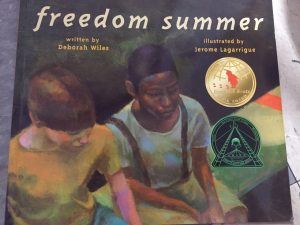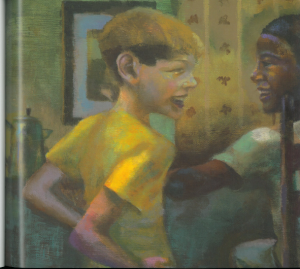
Author: Deborah Wiles
Illustrator: Jerome Lagarrigue
Publishing Information: Aladdin Paperbacks, 2001
Number of Pages: 27
Genre: Historical Fiction, Picture book


Analysis:
A white boy Joe makes friends with John Henry, the son of the maid of his family. They play together all the time. But there were a lot of laws and rules against black people back then. John Henry cannot get into the store from the front door or swim in the town pool even if he is the finest swimmer. Finally, John Henry decides to use the front door and Joe is right there with him.
The story is based on historical facts. The author grew up in Mobile, Alabama and usually spent her summer with her relatives in Mississippi as she mentioned in the book before she told the story (P. 1). The town pool there was not open to black people. However, when the Civil Rights Act was passed, she witnessed that the town pool was closed. The book serves as a window for children to look back at history and also as a mirror for readers to reflect what is right and what is wrong.
Both of the two characters of this book have strong personalities. John Henry is a nice boy and he would help his mother with her work. In the first half of the book, John Henry does not seem to care whether he could use the front door to the store or whether he could swim in the town pool. He grew up happily playing with Joe and having fun swimming in the creek. But once he realized the difference between rights of white people and rights of himself, he was sad and angry. “John Henry’s eyes fill up with angry tears” (P. 23). The purpose of this book is to expose children to racism. The author tries to convey her point of view that racism is wrong and it can truly hurt feelings of somebody who is so nice. In the book, the author depicts Joe as a sensitive and warmhearted little boy. He would give up going swimming in the town pool just to keep company with John Henry. At the end of the book, Joe and John Henry walked through the front door together. Joe did not ignore the importance of civil rights although he was not directly harmed. He would fight for his friend. He would fight for what is right.
Perceptually, the book uses narrative sentences to tell an engaging story. The whole book uses dark color a lot which conveys a depressing atmosphere. I can find a few bright colors in some of the happy scenes. I found it smart that the illustrator tried to narrow down the difference of Joe and John Henry’s skin colors. Structurally, the text and images are completely separated which helps children to get the story as a whole. Ideologically, this book stresses friendship based on diversity backgrounds. Also, it encourages minorities to stand up for their rights and reminds readers that Civil Rights are universal. It is crucial for everybody to be concerned with it and get involved.
